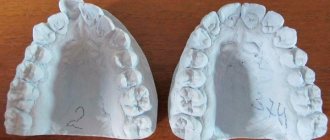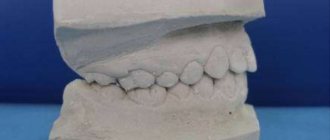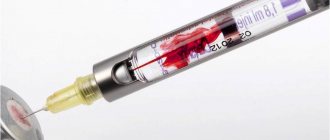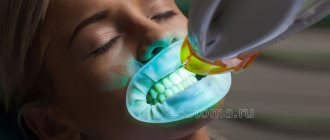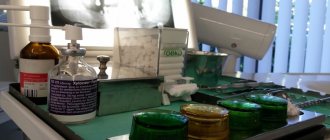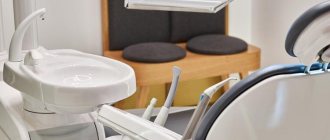1862
Technologists have thoroughly studied the physical properties of medical plastics, which has made it possible to widely introduce fast-hardening material into the practice of dentistry, orthodontics and maxillofacial surgery.
Orthodontic appliances are designed to correct abnormalities of the jaw system. However, the design of the devices will not function properly without fast-hardening materials.
In addition, acrylic substances are used to make dental crowns used in prosthetics.
General overview
Rapid-hardening plastics are also called self-hardening. In medical practice, the adaptation of this type of material has technologically changed the process of creating structures.
Peculiarities:
- the ability of the material to undergo accelerated polymerization at everyday room temperature, or human body temperature;
- high level of compatibility of the material with other forms of substances;
- there is no destructive effect of the material on the oral mucosa.
In addition, medical compounds are used to repair damaged prosthesis bases.
Also, materials of this type make it possible to restore a combined non-removable structure directly in the oral cavity .
Classification of polymers
Polymers used in prosthetic dentistry belong to one of three groups. Each of them is subject to different hygienic, toxicological, aesthetic, and technological requirements.
- Basic, or basic polymers in dentistry are used for the manufacture of artificial teeth and bases for removable dentures.
- Auxiliary - needed for impressions, molding and modeling.
- Clinical polymers include sealants, restoratives, and adhesives.
Composition and properties
Quick-hardening plastic masses are used in orthodontics in various variations, most often in the manufacture of removable and non-removable appliances and their parts.
Each factory package contains a powdery substance (varieties of acrylic), liquid (methyl methacrylate with various additives) and activators.
When these three components are combined, a solid dental material for prosthetics is formed, and polymerization occurs.
Functional features of the constituent elements:
- Powder is an ether polymer of methacrylic and acrylic acids with various metal additives. This substance also contains dyes and plasticizers. The powdery substance is the basis for creating materials.
- The liquid consists of ether compounds of methacrylic acid, chemical compounds similar in composition - monomers and various additives.
- Monomer is an ethereal transparent consistency with a strong characteristic odor.
Improper storage can cause self-polymerization, so it is important to tightly seal the bottle and add an inhibitor to prevent the substance from hardening. The function of this substance is to polymerize the composition without heating. - Fillers are able to add viscosity to the powder, increase the strength of the composition and protect polymers from rapid wear. In addition, there are antimicrobial fillers that prevent the formation of microorganisms in polymers.
High quality medical plastics must be packaged in kits containing liquid and powder.
What design of a removable denture for the upper jaw do dentists consider the best?
Come here if you are interested in the reasons for the development of denture stomatitis.
At this address https://www.vash-dentist.ru/protezirovanie/semnyie-p/vidov-pri-otsutstvii-bolshogo-kolichestva-zubov.html we will consider the types of prosthetics in the absence of a large number of teeth.
Water resistance and water absorption of polymers
Water resistance is the ability of polymers to retain their properties under prolonged exposure to water. If water gets inside the polymer, it swells, its shape is distorted, and its strength indicators suffer. Moisture resistance is resistance to humid air. Due to absorption, water vapor also causes swelling of hydrophilic materials. However, more often moisture accumulates in the surface layer due to adsorption, penetrating into microcracks.
The water resistance of the polymer is characterized by water absorption. This parameter indicates the amount of water that the material is able to absorb when kept at a temperature of 18-22 ° C for 23 hours. Due to water absorption, the geometric shape of the prosthesis base changes, and the mechanical properties deteriorate. The higher the water absorption, the more susceptible the polymer is to the penetration of microorganisms.
The presence of sorption water in the polymer sharply reduces its strength, hardness, rigidity, and indentation resistance. The polymer loses soluble substances, so its properties change.
Advantages and disadvantages
The materials are used in medicine for various purposes. Versatility is associated with a set of good basic physical and chemical properties.
The advantages of the material in orthodontics are undeniable:
- do not have harmful effects on the body;
- the material is highly durable and can withstand strong mechanical stress;
- the ability to eliminate the breakdown of a fixed prosthesis directly in the oral cavity;
- the ability of the material to quickly self-polish (harden) under normal conditions, which simplifies the process of filling teeth;
- has a color similar to the natural color of the dental crown;
- a fast, simplified material processing technique that reduces the time required for manipulations in the patient’s oral cavity.
However, there are also disadvantages:
- inexpensive types may have an unaesthetic appearance;
- may darken during prolonged use;
If the consistency is not prepared correctly, the material becomes insufficiently strong and is susceptible to chipping.
Popular products
Several basic types of plastics, which are universal, are widely used in dental practice.
The powdered composition should be mixed in certain proportions, and it can be used in different viscosity states.
Protacryl
The substance is classified as a basic type of self-hardening plastic. Supporting properties are distinguished:
- powder with a pink tint contains polymethyl methacrylates, initiators, activators, opacifiers, dyes;
- manufacturability and high strength;
- does not change color upon contact with oral tissues;
- used in the reconstruction of removable dentures;
- in case of loss of adhesiveness, it is used for restoration of bases.
In addition, the material is widely used for the manufacture of various orthodontic appliances.
Noracryl
This product is most often used in medical practice to restore damaged bridges.
Characteristics of Noracryl:
- contains three types of powders, two liquid catalysts and a liquid solvent, a filler that reduces water absorption;
- the resulting mass is used for filling dental canals and applied to the dental cavity;
- The curing time of the material is minimal and reaches 5-7 minutes.
The duration of mixing this type of material should not exceed one minute.
Carboplast
A polymeric substance with a yellow color. Characteristics of carboplast substance:
- the composition contains a ternary copolymer of methyl acrylate, butyl methacrylate, liquid, epoxy resin, stabilizer, filler - chalk;
- the material kneads well in the hands after mixing, this allows it to be evenly distributed over the plaster model;
- hardens at room temperature directly on the model.
Widely used when creating casts and models for further orthopedic work.
Redont
One of the forms produced for medical purposes in three main versions - opaque Redont, unpainted and transparent Redont-02, pink transparent Redont-03.
Characteristics:
- The product consists of powdered copolymer of methyl methacrylate and ethyl methacrylate, liquid methyl methacrylate, inhibitor, activator;
- used to restore broken dentures;
- used in the design of various medical mechanisms.
The main use of Redont is to move removable dentures in cases where the fit to the tissues of the oral cavity is disrupted or when there is a loss of adhesion to dental crowns.
Stadont
Acrylic substance having the following characteristics:
- main composition: methyl copolymer powder, opacifier and liquid methacrylic acid methyl ester, catalyst, stabilizer;
- factory markings contain substances of three different shades;
- are used in the production of medical fixing splints used in the presence of periodontal disease.
The main purpose of the product is to use it for the repair of bridge structures and removable plate prostheses.
Acrylic oxide
The product is white in color and has positive chemical characteristics:
- main composition - resins (acrylic and epoxy), mineral fillers;
- the product is not subject to shrinkage;
- has a color similar to the natural color of teeth;
- has high plasticity.
It is used for filling canals, making crowns, modeling dental inlays.
Carbondent
An acrylic substance having a composition with enhanced physical and chemical properties. Characteristics:
- the powder contains methyl acrylate ternary copolymer, butyl methacrylate, liquid with the addition of epoxy resin, mineral fillers, a stabilizer, a substance that protects the material from aging;
- The preparation kit contains 6 powders, differing in color type;
- improved characteristics of strength and adhesiveness.
A mass prepared from powder is used to create dental impressions.
Five popular models of containers for dentures and their features.
In this publication we will tell you what compensation pensioners are entitled to for dental prosthetics.
Here https://www.vash-dentist.ru/protezirovanie/semnyie-p/nedorogie-zubnyie-nadezhnyimi.html read about the types of inexpensive dentures.
Self-hardening plastics (cold polymerization).
These plastics are so named because polymerization of this group of materials occurs at low (usually room) temperatures. Shrinkage - 4-7%.
Representatives: Protacryl, Luxatemp (DMG), Protemp 3 (3M).
Cold-curing plastics are used in dentistry for correcting (relining) dentures, repairing dentures, making temporary dentures, and splints for periodontal diseases.
The advantage of these materials over hot-curing materials is their simpler technology. The disadvantage of quick-hardening plastics is the increased content of residual monomer in the polymer, resulting in reduced strength. During the polymerization of self-hardening plastics, a large amount of heat is released, which can cause the formation of large pores in the mass; after some time, the plastic changes its color.
Monomer-free plastic
Monomer-free plastic does not contain monomer, therefore it is not toxic and does not cause allergic reactions in patients. Ideal for patients who do not want or cannot, due to allergies or sensitivity problems, use dentures made from conventional dental plastics. With increasing medical awareness among patients and the need to eliminate toxic raw materials, biocompatible materials are becoming increasingly important in modern dentistry. Used for the manufacture of complete and partial removable dentures.
DENTAL CERAMICS
When talking about dental ceramics, two terms are often used to denote this class of restorative materials - ceramics and porcelain. The word "ceramics" comes from the Greek keramike - pottery art (keramos - clay). Ceramics include products and materials obtained by sintering clays and their mixtures with mineral additives, as well as oxides and other inorganic compounds. Porcelain is a white, translucent (transparent) ceramic that is fired to a glazed state.
Modern dental ceramics are the result of the improvement of hard materials, i.e. household decorative porcelain, and is something intermediate between it and glass. The first porcelain compositions had increased fragility. Their use in restorative dentistry was limited to the manufacture of artificial teeth and, in rare cases, crowns for single teeth. With the development of dental materials science and the improvement of materials for dental restoration, the use of ceramic materials has expanded significantly
According to their purpose, ceramic masses are the starting material for:
1) factory production of blanks for ceramic inlays;
2) individual production of ceramic crowns in a dental laboratory;
3) individual production of inlays in a dental laboratory;
4) lining of solid-cast frames of metal-ceramic fixed dentures (crowns, bridges).
Basic properties of dental ceramics
In terms of physical properties, dental ceramics are close to glass. Ceramics are formed as a result of a complex physical and chemical process of interaction of components at high temperatures.
Modern dental ceramics are classified according to firing temperature as refractory (1300-1370°C), medium-melting (1090-1260°C) and low-melting (870-1065°C).
Refractory ceramics were previously used for the factory production of artificial teeth for fixed dentures. Medium-melting and low-melting ceramics are used for the manufacture of crowns, inlays and bridges.
The optical properties of ceramics are one of the main advantages of artificial teeth. The crown of a natural tooth is translucent, but not transparent like glass. This is explained by the fact that, along with light absorption, transparency is expressed by the ratio of diffusely scattered and transmitted light. Light hitting the surface of a tooth can be absorbed, reflected and refracted.
The optical effect of ceramics is close to that of natural teeth in cases where it is possible to find the correct ratio between the glass phase and ceramic opacifiers. This is usually hampered by a large number of air pores and the clouding effect of crystals. Ceramics fired in a vacuum have 60 times fewer pores than with atmospheric firing.
When firing ceramic masses, shrinkage is 20-40%. The reasons for this shrinkage are:
· insufficient compaction (condensation) of ceramic mass particles;
· loss of liquid necessary for preparing ceramic slurry;
· burnout of organic additives (dextrin, sugar, starch, aniline dyes).
Various metal oxides are used to color dental porcelain - iron, titanium, cobalt and chromium. Other components are also added to the porcelain mass. For example, fluxes (fluxes). These substances lower the melting point of the porcelain mass (sodium carbonate, calcium carbonate, etc.). Their melting point is not higher than 800 °C. Plasticizers are substances that are added to porcelain masses that do not contain kaolin. Organic substances (dextrin, starch, sugar) are used as plasticizers, which completely burn out during firing. These substances are necessary to impart plasticity to the porcelain mass when wet.
Today, ceramics in dentistry are most often used for lining metal-ceramic dentures. This is one of the most common types of fixed prosthetics. Metal-ceramic crowns are a thin metal frame covered with a ceramic shell that accurately conveys the individual shade and shape of the tooth.
In order to eliminate the disadvantages inherent in metal-ceramic dentures, which arise primarily due to the combination of materials of different nature - metal and ceramics, dentists and materials scientists have directed their efforts to search for materials for the manufacture of dentures consisting entirely of ceramics, i.e. e. materials for so-called all-ceramic prostheses. All-ceramic dentures can be produced by a wide variety of methods, ranging from casting to milling of ceramic blocks using a computer program (CAD/CAM).
Using some methods, it is possible to produce only microprostheses (inlays, onlays, veneers) and single crowns, while others allow you to create longer dentures.
CAD/CAM systems based on the use of high technologies (Computer Aided Design/Computer Aided Manufacturing - computer modeling/computer control of the manufacturing process): Cerec, Siemens, Germany. Products are made by milling ceramic blocks using a computer program. The most famous of the CAD/CAM systems, Procera (Sweden), is designed for the production of an all-ceramic frame, which is densely sintered ceramic with a high content of high-purity aluminum oxide, which is lined with low-temperature All Ceram porcelain.
Aluminum oxide (Al2O3)
Ceramics based on aluminum oxide are biocompatible and chemically stable, absolutely non-toxic and hypoallergenic, i.e. does not have a pathological effect on teeth and surrounding tissues.
The production of ceramic frames using the TURKOM-CERA technology does not require expensive equipment; all equipment necessary for production is available in any laboratory (electric vacuum furnace, burner, dental motor). And therefore, this is the cheapest system in the class of metal-free prosthetics.
The Turkom-Cera system (framework made of sintered Al2O3 powder infiltrated with glass) can be recommended for the manufacture of orthopedic structures that are not subject to sufficiently strong chewing loads. The CAD/CAM Cerec System has similar strength characteristics (framework made of milled semi-sintered Al2O3 followed by finishing sintering of VITA In-Ceram ALUMINA ceramics). These two systems are used to make inlays (onlays, inlays, overlays, pinlays), onlays, veneers and single crowns for the anterior teeth.
II.SUPPORTING MATERIALS
The process of creating a denture of any type and design begins with taking an impression - a negative image of the hard and soft tissues of the patient’s mouth. The impression is taken by a dentist when a patient is seen in an orthopedic clinic. Based on the impression obtained, diagnostic and working models are made from plaster. A working or master model is used to make a denture on it.
First, the prosthesis is made from temporary materials, the so-called modeling materials, the main representative of which is wax, or rather various wax compositions. At the next stage, the wax is replaced with the base material (plastic, ceramic, metal alloy). Replacement is carried out after making a mold, for which ordinary medical plaster or special molding materials are used, in which gypsum can also be used. After replacing the wax in the denture model with a permanent base restorative material, the finished denture is removed from the mold, cleaned of molding material residues, ground and polished. Thus, the main stages of denture manufacturing technology include the use of at least five types of auxiliary materials.
Stages of manufacturing dentures and auxiliary materials for each stage.
Features of application
It is necessary to use products for medical purposes only if mixed in the correct proportions.
Features of the use of materials:
- The liquid is mixed with the powdered composition until a viscous substance is formed. Excess monomer can lead to increased material shrinkage, porosity and poor coloration.
The mixed composition is tightly closed. Over a half-hour period of time, the mass swells and goes through several stages: sandy, viscous, dough-like, rubbery. - The polymerization mode occurs when immersed in water or heated and the presence of an activator. The individual regimen must correspond to the description on the packaging.
It is important to follow the instructions exactly, because if the polymerization process is shortened, there will be an excess of monomer, which will provoke inflammatory processes in the mucous membrane. If overheated, it will become excessively brittle. - During the production of prostheses, the formation of porosity in the material is possible. This phenomenon occurs during accelerated polymerization and when there is a lack of monomer.
If the proportions are observed, the listed phenomena and deformation can be avoided. Depending on the stage of swelling, specialists use the material for filling, making devices, and making impressions.
The video discusses the properties of quick-hardening plastic for the manufacture of prostheses.
New trends in the production of base polymers
In the last few years, there has been a tendency to introduce aesthetic fibers into the structure of hot-curing base polymers. They look more advantageous, but they are inferior to the standard ones in terms of physical and mechanical properties. “Veins” in the structure of polymers lead to the formation of microvoids and reduce the density of the material. Oxygen in microvoids increases the number of monomers. Therefore, such polymers with improved aesthetic characteristics should be used only when indicated - in rare cases.
Despite certain disadvantages, acrylic plastics remain the most common material for the production of removable denture bases. Their main advantages are low price, manufacturability and lack of need for expensive equipment.
Reviews
Plastics have the ability to quickly harden under normal conditions, so they are widely used in medical practice for filling, manufacturing and repairing devices.
You can share your feedback on the use of plastics in the comments to this article.
If you find an error, please select a piece of text and press Ctrl+Enter.
Tags prosthetics removable dentures
Did you like the article? stay tuned
Previous article
Types of complications that arise after dental prosthetics and treatment tactics
Next article
What justifies the popularity of French TBR implants in many countries around the world?

